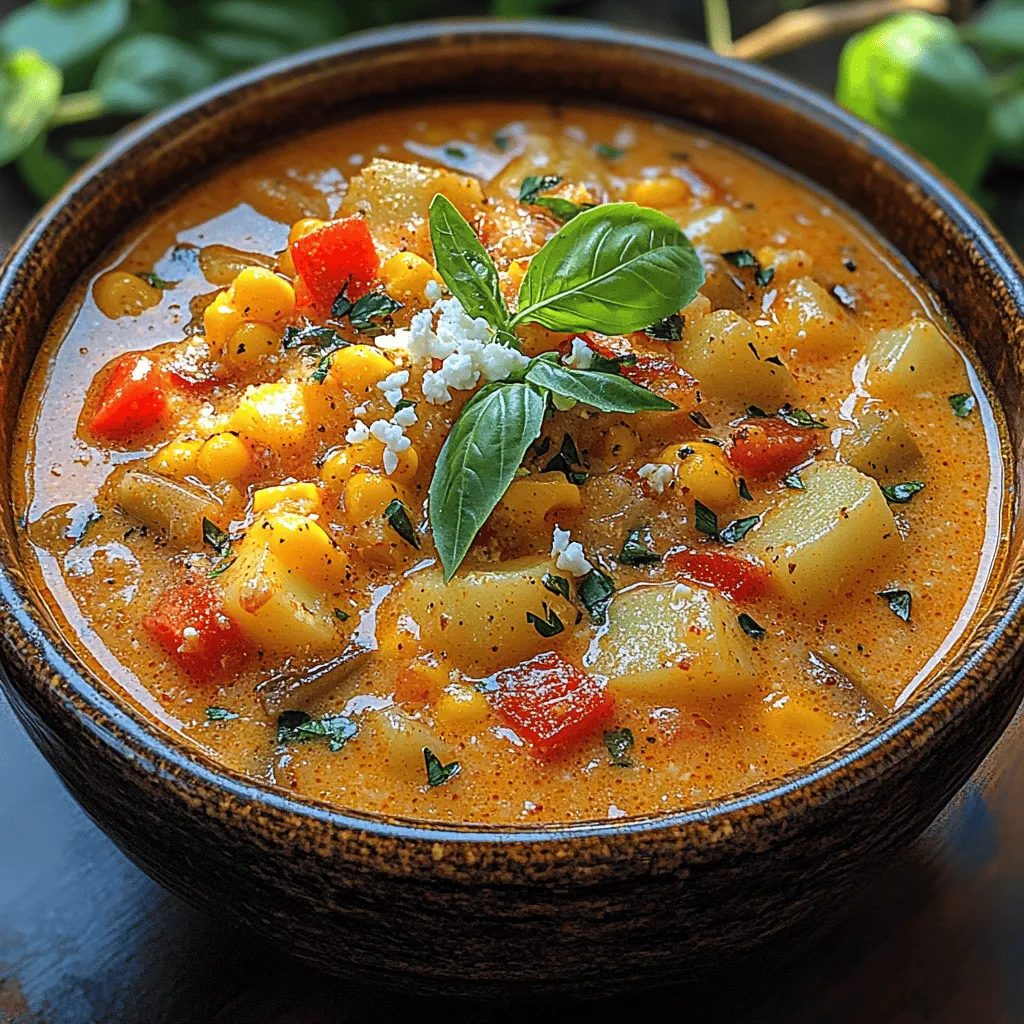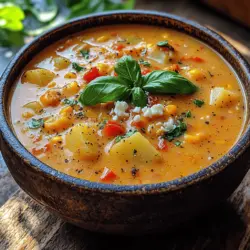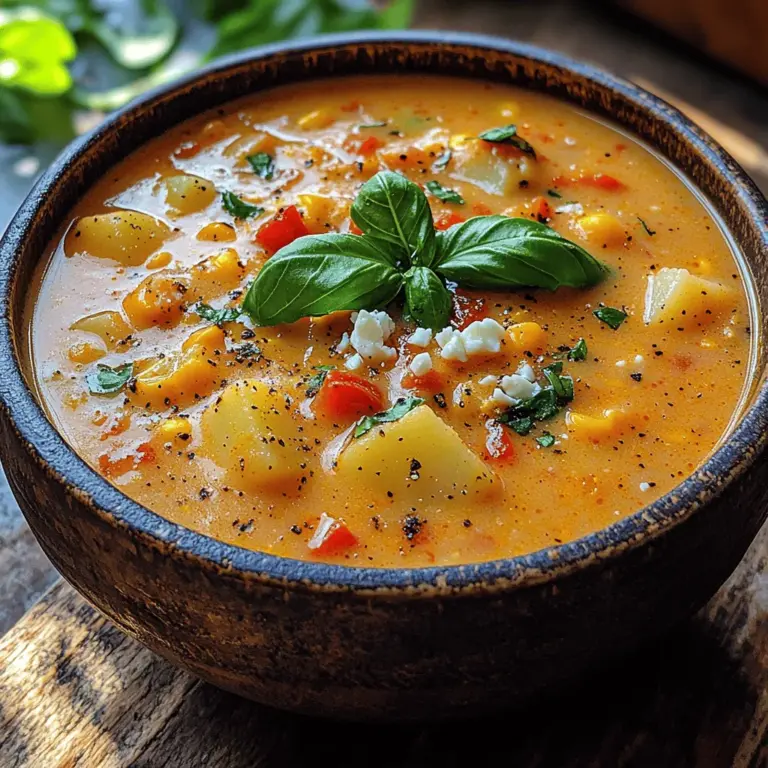Introduction
As the warm sun casts its golden glow and the days stretch longer, there’s an undeniable allure to summer’s bounty. Among the seasonal treasures, fresh corn stands out, celebrated for its sweetness and versatility. Our Heavenly Summer Corn Chowder encapsulates the essence of summer, transforming this beloved ingredient into a comforting dish that’s perfect for warm weather dining. This chowder is a celebration of fresh produce, featuring vibrant vegetables and a rich, creamy base that will surely delight your taste buds and bring smiles to your table.
Whether you’re hosting a backyard barbecue or simply enjoying a sunny afternoon, this chowder is an ideal choice for a wholesome meal that can be shared with family and friends. In this article, we will explore the origins and significance of corn chowder, break down the ingredients needed for our heavenly recipe, and guide you through the preparation steps to create a dish that embodies the spirit of summer.
Understanding Corn Chowder
Exploring the History and Origin of Corn Chowder
Corn chowder has deep roots in American culinary tradition, particularly in New England, where it has been a staple comfort food for generations. The dish is believed to have evolved from the indigenous peoples who cultivated corn, or maize, long before European settlers arrived. These early inhabitants often prepared corn in various ways, including soups and stews, making it a significant part of their diet.
As settlers began to adopt and adapt native recipes, corn chowder emerged as a popular dish, especially during harvest season when fresh corn was abundant. Traditionally, chowders are thick, chunky soups made with a variety of ingredients, including seafood, vegetables, and grains. Over time, corn chowder has seen numerous variations, incorporating the flavors and preferences of different cultures and regions.
The Significance of Corn in Summer Cuisine
Corn is often heralded as the quintessential summer vegetable, and for good reason. It thrives in warm climates and is at its peak during the summer months, making it a staple in many seasonal dishes. The natural sweetness of fresh corn complements a variety of flavors, from savory to spicy, and it serves as a delicious base for soups, salads, and salsas.
In addition to its delightful taste, corn is packed with nutritional benefits. It is a good source of dietary fiber, vitamins B and C, and essential minerals such as magnesium and potassium. This makes it not only a flavorful addition to summer meals but also a nourishing one. Whether grilled, roasted, or used in chowders, corn brings a taste of summer’s freshness to every dish.
Variations of Corn Chowder Across Different Cultures
While the classic corn chowder is beloved in American cuisine, variations of this dish exist around the world, each showcasing local ingredients and culinary traditions. For example, in Mexico, corn is often combined with chili peppers and spices to create a vibrant soup known as “sopa de elote.” In the Caribbean, corn is sometimes used in stews, where it pairs beautifully with coconut milk and tropical spices.
In many southern regions of the United States, corn chowder may incorporate elements of gumbo or jambalaya, featuring smoked meats and bold seasonings. These variations highlight the adaptability of corn as an ingredient and its ability to take on diverse flavors, making it a global favorite.
Ingredients Breakdown
To create the Heavenly Summer Corn Chowder, you’ll need a selection of fresh, high-quality ingredients that enhance the dish’s flavor profile. Let’s break down each component:
Fresh Corn Kernels: The Star of the Dish
The key ingredient in any corn chowder is, of course, the corn. Fresh corn kernels, harvested at the peak of ripeness, provide the sweetness and texture that define this dish. When selecting corn, look for ears that are bright green, tightly wrapped, and filled with plump kernels. The sweetness of fresh corn is unmatched, and it forms the backbone of this delightful chowder.
Diced Onion and Garlic: Aromatic Foundations
No chowder is complete without the aromatic base of onion and garlic. Diced onions add a subtle sweetness and depth of flavor, while garlic brings a warm, savory note. Together, they create a fragrant foundation that enhances the overall taste of the chowder.
Red Bell Pepper: Adding Color and Sweetness
To brighten up the chowder visually and flavor-wise, diced red bell pepper is added. Its sweet, crisp texture contrasts beautifully with the creamy base of the soup. Additionally, the vibrant color of the bell pepper makes the dish more appealing and inviting.
Potatoes: The Perfect Filler for a Hearty Chowder
To achieve a satisfying and hearty texture, diced potatoes are included in the recipe. They absorb the flavors of the chowder while providing a comforting creaminess. Choose waxy potatoes, such as Yukon Gold or red potatoes, as they hold their shape well during cooking and add a lovely texture to the dish.
Vegetable Broth: A Base for Depth of Flavor
For the liquid component, vegetable broth is used to create a flavorful base. It adds depth and richness without overpowering the sweetness of the corn. If you prefer a heartier flavor, you can opt for homemade broth or select a high-quality store-bought option. This ingredient is essential for enhancing the overall taste of the chowder.
Milk and Cream: The Creamy Texture That Binds It All
The combination of milk and cream is what makes this chowder luxuriously creamy. Whole milk provides a smooth consistency, while heavy cream adds richness that elevates the dish. For a lighter version, you can adjust the ratios or use low-fat milk, but the creaminess is part of what makes this chowder so heavenly.
Seasonings: The Role of Smoked Paprika and Herbs
To elevate the flavor profile further, a blend of seasonings is included. Smoked paprika adds a subtle smokiness that complements the sweetness of the corn. Fresh herbs, such as thyme or parsley, bring a burst of freshness, rounding out the flavors beautifully. The right balance of seasonings is crucial in making your chowder truly memorable.
Optional Toppings: Enhancing Flavor with Cheese and Herbs
While the chowder is delicious on its own, optional toppings can take it to the next level. Consider adding crumbled feta or grated cheddar cheese for a salty contrast, or a sprinkle of fresh herbs for a vibrant finish. A drizzle of olive oil or a dash of hot sauce can also add an extra layer of flavor, inviting your guests to customize their bowls.
Preparation Steps for Heavenly Summer Corn Chowder
Now that we’ve explored the ingredients, let’s dive into the preparation steps for creating your own Heavenly Summer Corn Chowder. These steps will guide you through the process, ensuring that you achieve the perfect balance of flavors and textures.
Husk and Prepare the Corn: Best Practices for Fresh Corn
The first step in making the chowder is to prepare the fresh corn. Begin by husking the corn, removing the green outer leaves and silk carefully. After husking, rinse the ears under cool water to remove any remaining silk.
Once cleaned, use a sharp knife to cut the kernels off the cob. Hold the ear upright in a large bowl to catch the kernels as you slice. This method minimizes mess and allows you to collect all the sweet corn pieces easily. If fresh corn isn’t available, frozen corn can be a suitable substitute, but nothing compares to the flavor of freshly harvested corn.
Sauté the Aromatics: Building Flavor
In a large pot or Dutch oven, heat a drizzle of olive oil over medium heat. Add the diced onions and cook until they become translucent, about 4-5 minutes. Then, add the minced garlic and sauté for an additional 1-2 minutes, being careful not to let it burn. This step is essential as it builds the foundation of flavor for your chowder.
Add the Vegetables: Creating the Chowder Base
Once the aromatics are ready, it’s time to add the diced red bell pepper and potatoes to the pot. Stir everything together and let the vegetables cook for a few minutes, allowing their flavors to meld. This step is crucial for ensuring that the potatoes begin to soften while absorbing the delicious aromas from the onions and garlic.
Incorporate the Fresh Corn and Broth: Bringing It All Together
After the vegetables have sautéed, add the freshly cut corn kernels to the pot and stir to combine. Pour in the vegetable broth, bringing the mixture to a gentle simmer. The broth will infuse the chowder with savory notes while allowing the corn to shine.
Simmer and Finish with Cream: The Final Touch
Allow the chowder to simmer for about 15-20 minutes, or until the potatoes are tender. Once they reach the desired softness, reduce the heat and stir in the milk and heavy cream. This will create the luscious, creamy texture that makes this chowder so heavenly. Continue to heat the chowder gently for a few more minutes, just enough to warm the cream without boiling it.
With these initial steps, you’re well on your way to creating a delightful summer dish that showcases the beauty of corn. The next part of this article will dive into additional tips for achieving the best results, as well as answers to common questions about this beloved recipe. Stay tuned for more insights on how to make your Heavenly Summer Corn Chowder truly unforgettable!

Sautéing Aromatics: Techniques for Enhancing Flavor
To create a truly heavenly summer corn chowder, the first step is to sauté the aromatics properly. Aromatics, such as onions, garlic, and bell peppers, are essential in building the foundational flavors of the dish. Start by heating a generous amount of olive oil in a large pot over medium heat. Add finely chopped onions and sauté them until they become translucent, about 5 minutes. This process releases their natural sweetness, which will enhance the overall flavor of the chowder.
Next, add minced garlic and diced bell peppers. Sauté these for another 2-3 minutes until the garlic is fragrant and the bell peppers are slightly softened. Avoid browning the garlic, as it can impart a bitter taste to the chowder. For an added layer of flavor, consider incorporating fresh herbs like thyme or rosemary during this step. Fresh herbs can elevate the dish, providing a depth that’s particularly enjoyable in summer recipes.
Incorporating Vegetables: Building Layers of Taste
Once you have your aromatics sautéed to perfection, the next step is to incorporate the vegetables. The star of the show is, of course, the fresh corn. If you’re using fresh cobs, cut the kernels off and set them aside. You can also use frozen corn if fresh is not available, but fresh corn adds a sweetness that is hard to beat.
Along with corn, add other complementary vegetables such as diced potatoes and carrots. The potatoes will give the chowder a creamy texture when cooked, while the carrots add a pop of color and sweetness. Toss the diced vegetables into the pot and stir them well to coat with the aromatic mixture. This is the moment to let the vegetables mingle and absorb the flavors already in the pot.
Simmering to Perfection: The Importance of Cooking Time
Simmering is where the magic of flavor melding happens. After adding the corn and other vegetables, pour in your choice of broth—vegetable or chicken broth works wonderfully. Bring the mixture to a boil, then reduce the heat to low and let it simmer uncovered for about 20-25 minutes. This gentle cooking process softens the vegetables, allowing their flavors to infuse into the chowder.
It’s essential to taste the chowder during this phase. Adjust the seasoning with salt and freshly cracked black pepper as needed. The simmering time is crucial; if you rush it, the vegetables won’t have enough time to soften, and the flavors will remain stark rather than harmonious.
Blending Techniques: Achieving the Desired Consistency
Once the chowder has simmered, it’s time to achieve that velvety consistency that makes corn chowder so irresistible. You can choose to blend the chowder entirely for a smooth texture or partially for a chunky style, depending on your preference.
For a completely smooth chowder, use an immersion blender directly in the pot until it reaches your desired consistency. Alternatively, if you prefer a mix of textures, transfer about half of the chowder to a blender, blend until smooth, and then return it to the pot. This method allows you to enjoy the creamy base while still having chunks of vegetables and corn throughout.
Final Touches: Adjusting Flavors and Textures
After blending, it’s time for the final touches. Return the pot to low heat and stir in heavy cream or a dairy-free alternative if you want to keep it vegan. This addition enriches the chowder, giving it that signature creamy texture. If you’re using dairy, consider adding a splash of lemon juice or a dash of hot sauce to brighten the flavors.
Taste again for seasoning and adjust as necessary; sometimes, a pinch of sugar can help round out the flavors, especially if the corn is not as sweet as you hoped.
Nutritional Benefits of Corn Chowder
Highlighting the Health Benefits of Fresh Corn
Corn is not only delicious but also packed with nutrients. It is a good source of fiber, which aids digestion and may help lower cholesterol levels. Moreover, corn is rich in antioxidants, including lutein and zeaxanthin, which are beneficial for eye health. Enjoying corn chowder allows you to indulge in the flavors of summer while also reaping the nutritional rewards of this vibrant vegetable.
The Nutritional Value of the Added Vegetables
The added vegetables in your chowder contribute significantly to its nutritional profile. Potatoes provide potassium, crucial for blood pressure regulation, and carrots are an excellent source of beta-carotene, which promotes healthy skin and vision. By incorporating a variety of vegetables, you’re not only enhancing the flavor but also adding vitamins, minerals, and essential nutrients to your meal.
Understanding Dairy Options and Their Health Implications
When it comes to the creamy aspect of corn chowder, there are various dairy options available. Traditional heavy cream adds richness but is calorie-dense. For a lighter alternative, consider using half-and-half or whole milk. If you’re aiming for a dairy-free version, plant-based creams made from nuts or coconut can provide similar creaminess without the dairy.
Vegan Alternatives for a Plant-Based Diet
For those following a vegan lifestyle, it’s easy to adapt corn chowder. Substitute heavy cream with coconut milk or cashew cream. Both options offer a creamy texture and delicious flavor. Additionally, vegetable broth ensures the dish remains entirely plant-based while still being satisfying and nourishing.
Serving Suggestions and Pairings
Best Ways to Serve Chowder: Bowls, Garnishes, and More
Serving corn chowder can be as simple or as elaborate as you like. For a classic presentation, ladle the chowder into warm bowls and garnish with fresh herbs like chopped chives or parsley. You can also add a sprinkle of smoked paprika for a hint of smokiness and color. A drizzle of olive oil or a dollop of sour cream can elevate the dish even further.
Complementary Side Dishes: Salads, Breads, and Snacks
Corn chowder pairs wonderfully with various side dishes. A fresh garden salad with a light vinaigrette complements the richness of the chowder beautifully. For something heartier, serve it alongside crusty bread or cornbread for dipping. If you want to keep it light, consider pairing it with a refreshing cucumber salad or a simple fruit salad.
Beverage Pairings: Wine, Beer, and Non-Alcoholic Options
When it comes to beverages, you have plenty of options. A crisp, chilled white wine like Sauvignon Blanc or a light lager works well with corn chowder. If you prefer non-alcoholic beverages, consider serving it with iced tea or lemonade for a refreshing contrast to the warm soup.
Storing and Reheating Corn Chowder
Proper Storage Methods for Leftovers
If you have leftovers, store the corn chowder in an airtight container in the refrigerator for up to three days. For longer storage, consider freezing it in freezer-safe containers. Ensure you leave some space at the top of the container, as the chowder will expand when frozen.
Best Practices for Reheating to Maintain Flavor and Texture
When reheating corn chowder, do so gently to avoid curdling the cream. Place it in a pot over medium-low heat, stirring occasionally until heated through. You may need to add a splash of broth or water to adjust the consistency. If using the microwave, reheat in short intervals, stirring in between to ensure even heating.
Conclusion
Heavenly Summer Corn Chowder is more than just a dish; it’s a celebration of summer’s bounty. With its rich flavors and creamy texture, it’s a delightful way to enjoy seasonal produce. Whether you make it for a family gathering or a quiet evening at home, this chowder is sure to bring smiles and satisfaction with every spoonful. Embrace the season and indulge in this comforting bowl of goodness that will warm your heart and nourish your body. Try this recipe today, and let the vibrant flavors of summer corn inspire your culinary adventures!

